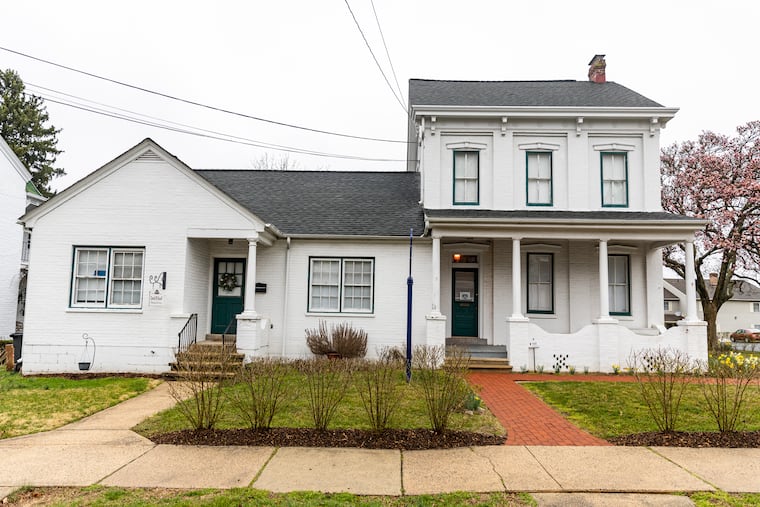Step inside Pulitzer Prize-winner John Updike’s childhood home in Shillington, Pa.
The house, listed on the National Register of Historic Places, has been restored to serve as a museum honoring one of America’s most noted authors.

SHILLINGTON, Pa. — Philadelphia Avenue is trembling with traffic as motorists lock horns in a vehicular mayhem that would not have existed eight decades ago when a boy named John Updike lived and played in the two-story white house at No. 117. This is where, by the author’s admission, his “artistic eggs were hatched.”
“John Updike (1932-2009) Two-time Pulitzer Prize winner and one of America’s most noted authors, Updike lived here until age thirteen,” a state historic sign reads in front of the house. Updike often revisited as an adult, and made the rooms, furnishings, and occupants of his childhood home settings for his short stories and novels.
The house, listed on the National Register of Historic Places, has been professionally restored to look as it did during Updike’s days here, but the “John Updike Childhood Home” museum is still a work-in-progress. It just received an Olivetti manual typewriter that was used by Updike.
A sign just inside the doorway counsels, “Maximum Occupancy: 60 People.”
There were only five people here between 1939 and 1945: Updike; his tempestuous mother, Linda; his math-teacher father, Wesley; and his two maternal grandparents. In his short story “Kinderszenen,” Updike’s alter ego is a 12-year-old boy named Toby, who recounts the adults in his house. “There are four — Mother, Daddy, Grandfather, and Grandmother — the same way the house has four sides.”
» READ MORE: Tracing Updike's roots
Updike’s fiction, in fact, was one of the restoration company’s major sources of information. The house is now owned and operated by the John Updike Society, whose president is James Plath, an Illinois Wesleyan University professor. “What makes this house so special,” Plath said, “is that all of his life Updike treasured his memories of it.”
The protagonist in his first novel, The Poorhouse Fair, Plath explained, is based on his grandfather. His father is the main character in his third novel, The Centaur, and the house itself is a character in short stories such as “The Black Room” and “The Brown Chest.”
When Updike visited in 1989, he complained about the absence of the gingerbread trim and columns in the living room. Pride creeps into Plath’s voice. “They’re back,” he said.
There are 10 rooms of exhibits, many with explanatory storyboards: items owned by the Updikes and original to the house. His high school transcript shows nearly all A’s except physical education. Copies of the Chatterbox, the high school newspaper to which Updike contributed many articles. The guest bedroom features his mother’s typewriter, on which he typed his first words.
Updike and his mother painted the moon and stars on the headboard. In the dining room are the dominoes that Updike and his friend would play with. Smiling down from the living room wall is a portrait of Updike done by Ernest Hemingway’s grandson Edward.
As Plath entered the parents’ bedroom, he noted how one had to pass through the room to get to Updike’s bedroom. “His little room was tucked behind theirs, at the back of the house,” Updike writes in “The Laughter of the Gods.”
The tiny bedroom has his toys and books, ranging from Dumbo to The Lone Ranger, and some of the clothes he wore as a toddler. And a bowl of marbles that were found under the floorboards. A childhood friend had no recollection of playing marbles but said he and John would use slingshots to shoot them out the bedroom window.
Updike was inconsolable when, at his mother’s insistence, the Updikes moved from 117 Philadelphia Avenue to a farm owned by her family. He wrote in a poem, “We have one home, the first.”
From the time his first short story was purchased by the New Yorker in 1954, until his death in 2009 at the age of 77, Updike wrote 30 novels, 14 volumes of short stories, nine of poetry, and 10 collections of essays and criticism. He is one of only four writers to win the Pulitzer Prize for Fiction more than once.
When I visited in March, there was a soon-to-blossom dogwood tree outside the house that was planted by Updike’s grandparents to mark his first birthday, in 1933. Across the street, standing cheek by jowl, are rowhouses — “above concrete retaining walls, looking down at Lee’s house like choirs of angels” — just as he described them in his short story “The Guardians.”
The John Updike Childhood Home, 117 Philadelphia Ave, Shillington, Pa., is open to the public from noon-2 p.m. on Saturdays except for major holidays. Admission is $5 for ages 16 and older. johnupdikechildhoodhome.com